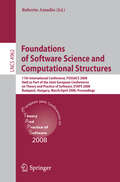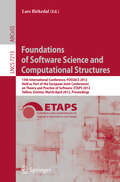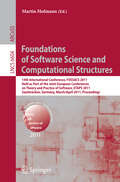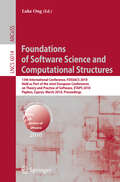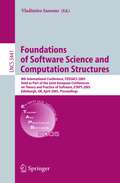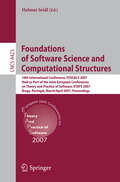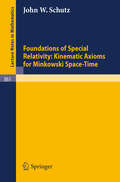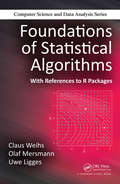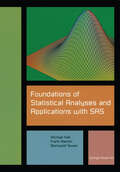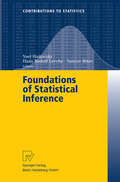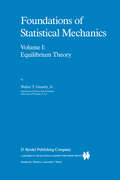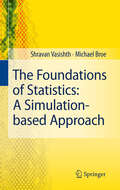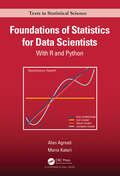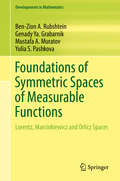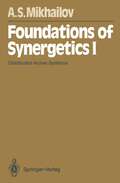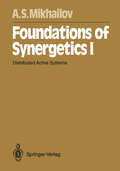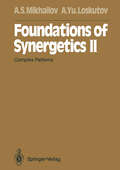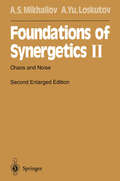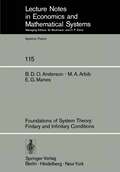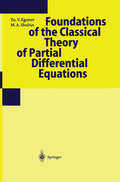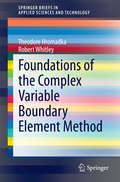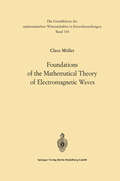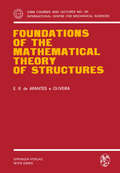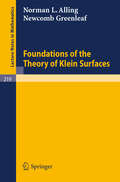- Table View
- List View
Foundations of Software Science and Computational Structures: 11th International Conference, FOSSACS 2008, Held as Part of the Joint European Conferences on Theory and Practice of Software, ETAPS 2008, Budapest, Hungary, March 29 - April 6, 2008, Proceedings (Lecture Notes in Computer Science #4962)
by Roberto AmadioFoundations of Software Science and Computational Structures: 15th International Conference, FOSSACS 2012, Held as Part of the European Joint Conferences on Theory and Practice of Software, ETAPS 2012, Tallinn, Estonia, March 24 -- April 1, 2012, Proceedings (Lecture Notes in Computer Science #7213)
by Lars BirkedalThis book constitutes the proceedings of the 15th International Conference on Foundations of Software Science and Computational Structures, FOSSACS 2012, held as part of the joint European Conference on Theory and Practice of Software, ETAPS 2012, which took place in Tallinn, Estonia, in March/April 2012. The 29 papers presented in this book together with two invited talks in full paper length were carefully reviewed and selected from 100 full paper submissions. The papers deal with theories and methods to support analysis, synthesis, transformation and verification of programs and software systems.
Foundations of Software Science and Computational Structures: 14th International Conference, FOSSACS 2011, Held as Part of the Joint European Conference on Theory and Practice of Software, ETAPS 2011, Saarbrücken, Germany, March 26--April 3, 2011, Proceedings (Lecture Notes in Computer Science #6604)
by Martin HofmannThis book constitutes the refereed proceedings of the 14th International Conference on Foundations of Software Science and computational Structures, FOSSACS 2011, held in Saarbrücken, Germany, March 26—April 3, 2011, as part of ETAPS 2011, the European Joint Conferences on Theory and Practice of Software. The 30 revised full papers presented together with one full-paper length invited talk were carefully reviewed and selected from 100 submissions. The papers are organized in topical sections on coalgebra and computability, type theory, process calculi, automata theory, semantics, binding, security, and program analysis.
Foundations of Software Science and Computational Structures: 13th International Conference, FOSSACS 2010, Held as Part of the Joint European Conferences on Theory and Practice of Software, ETAPS 2010, Paphos, Cyprus, March 20-28, 2010, Proceedings (Lecture Notes in Computer Science #6014)
by Luke OngFoundations of Software Science and Computational Structures: 8th International Conference, FOSSACS 2005, Held as Part of the Joint European Conferences on Theory and Practice of Software, ETAPS 2005 (Lecture Notes in Computer Science #3441)
by Vladimiro SassoneETAPS 2005 was the eighth instance of the European Joint Conferences on Theory and Practice of Software. ETAPS is an annual federated conference that was est- lished in 1998 by combining a number of existing and new conferences. This year it comprised ?ve conferences (CC, ESOP, FASE, FOSSACS, TACAS), 17 satellite wo- shops (AVIS, BYTECODE, CEES, CLASE, CMSB, COCV, FAC, FESCA, FINCO, GCW-DSE, GLPL, LDTA, QAPL, SC, SLAP, TGC, UITP), seven invited lectures (not including those that were speci?c to the satellite events), and several tutorials. We - ceived over 550 submissions to the ?ve conferences this year, giving acceptance rates below 30% for each one. Congratulations to all the authors who made it to the ?nal program! I hope that most of the other authors still found a way of participating in this exciting event and I hope you will continue submitting. The events that comprise ETAPS address various aspects of the system devel- ment process, including speci?cation, design, implementation, analysis and impro- ment. The languages, methodologies and tools which support these activities are all well within its scope. Di?erent blends of theory and practice are represented, with an inclination towards theory with a practical motivation on the one hand and soundly based practice on the other. Many of the issues involved in software design apply to systems in general, including hardware systems, and the emphasis on software is not intended to be exclusive.
Foundations of Software Science and Computational Structures: 10th International Conference, FOSSACS 2007, Held as Part of the Joint European Conferences on Theory and Practice of Software, ETAPS 2007, Braga, Portugal, March 24-April 1, 2007, Proceedings (Lecture Notes in Computer Science #4423)
by Helmut SeidlThis book constitutes the refereed proceedings of the 10th International Conference on Foundations of Software Science and Computation Structures, FOSSACS 2007, held in Braga, Portugal in March/April 2007. The 25 revised full papers presented together with the abstract of one invited talk cover a broad spectrum on theories and methods to support analysis, synthesis, transformation and verification of programs and software systems.
Foundations of Special Relativity: Kinematic Axioms for Minkowski Space-Time (Lecture Notes in Mathematics #361)
by J. W. SchutzFoundations of Statistical Algorithms: With References to R Packages (Chapman And Hall/crc Computer Science And Data Analysis Ser.)
by Claus WeihsA new and refreshingly different approach to presenting the foundations of statistical algorithms, Foundations of Statistical Algorithms: With References to R Packages reviews the historical development of basic algorithms to illuminate the evolution of today's more powerful statistical algorithms. It emphasizes recurring themes in all statistical
Foundations of Statistical Analyses and Applications with SAS
by Michael Falk Frank Marohn Bernward TewesThis book links up the theory of a selection of statistical procedures used in general practice with their application to real world data sets using the statistical software package SAS (Statistical Analysis System). These applications are intended to illustrate the theory and to provide, simultaneously, the ability to use the knowledge effectively and readily in execution.
Foundations of Statistical Inference: Proceedings of the Shoresh Conference 2000 (Contributions to Statistics)
by Yoel Haitovsky Hans Rudolf Lerche Yaacov RitovThis volume is a collection of papers presented at a conference held in Shoresh Holiday Resort near Jerusalem, Israel, in December 2000 organized by the Israeli Ministry of Science, Culture and Sport. The theme of the conference was "Foundation of Statistical Inference: Applications in the Medical and Social Sciences and in Industry and the Interface of Computer Sciences". The following is a quotation from the Program and Abstract booklet of the conference. "Over the past several decades, the field of statistics has seen tremendous growth and development in theory and methodology. At the same time, the advent of computers has facilitated the use of modern statistics in all branches of science, making statistics even more interdisciplinary than in the past; statistics, thus, has become strongly rooted in all empirical research in the medical, social, and engineering sciences. The abundance of computer programs and the variety of methods available to users brought to light the critical issues of choosing models and, given a data set, the methods most suitable for its analysis. Mathematical statisticians have devoted a great deal of effort to studying the appropriateness of models for various types of data, and defining the conditions under which a particular method work. " In 1985 an international conference with a similar title* was held in Is rael. It provided a platform for a formal debate between the two main schools of thought in Statistics, the Bayesian, and the Frequentists.
Foundations of Statistical Mechanics: Equilibrium Theory (Fundamental Theories of Physics #19)
by W.T. Grandy Jr.In a certain sense this book has been twenty-five years in the writing, since I first struggled with the foundations of the subject as a graduate student. It has taken that long to develop a deep appreciation of what Gibbs was attempting to convey to us near the end of his life and to understand fully the same ideas as resurrected by E.T. Jaynes much later. Many classes of students were destined to help me sharpen these thoughts before I finally felt confident that, for me at least, the foundations of the subject had been clarified sufficiently. More than anything, this work strives to address the following questions: What is statistical mechanics? Why is this approach so extraordinarily effective in describing bulk matter in terms of its constituents? The response given here is in the form of a very definite point of view-the principle of maximum entropy (PME). There have been earlier attempts to approach the subject in this way, to be sure, reflected in the books by Tribus [Thermostat ics and Thermodynamics, Van Nostrand, 1961], Baierlein [Atoms and Information Theory, Freeman, 1971], and Hobson [Concepts in Statistical Mechanics, Gordon and Breach, 1971].
The Foundations of Statistics: A Simulation-based Approach
by Shravan Vasishth Michael BroeStatistics and hypothesis testing are routinely used in areas (such as linguistics) that are traditionally not mathematically intensive. In such fields, when faced with experimental data, many students and researchers tend to rely on commercial packages to carry out statistical data analysis, often without understanding the logic of the statistical tests they rely on. As a consequence, results are often misinterpreted, and users have difficulty in flexibly applying techniques relevant to their own research — they use whatever they happen to have learned. A simple solution is to teach the fundamental ideas of statistical hypothesis testing without using too much mathematics. This book provides a non-mathematical, simulation-based introduction to basic statistical concepts and encourages readers to try out the simulations themselves using the source code and data provided (the freely available programming language R is used throughout). Since the code presented in the text almost always requires the use of previously introduced programming constructs, diligent students also acquire basic programming abilities in R. The book is intended for advanced undergraduate and graduate students in any discipline, although the focus is on linguistics, psychology, and cognitive science. It is designed for self-instruction, but it can also be used as a textbook for a first course on statistics. Earlier versions of the book have been used in undergraduate and graduate courses in Europe and the US. ”Vasishth and Broe have written an attractive introduction to the foundations of statistics. It is concise, surprisingly comprehensive, self-contained and yet quite accessible. Highly recommended.” Harald Baayen, Professor of Linguistics, University of Alberta, Canada ”By using the text students not only learn to do the specific things outlined in the book, they also gain a skill set that empowers them to explore new areas that lie beyond the book’s coverage.” Colin Phillips, Professor of Linguistics, University of Maryland, USA
Foundations of Statistics for Data Scientists: With R and Python (Chapman & Hall/CRC Texts in Statistical Science)
by Alan Agresti Maria KateriFoundations of Statistics for Data Scientists: With R and Python is designed as a textbook for a one- or two-term introduction to mathematical statistics for students training to become data scientists. It is an in-depth presentation of the topics in statistical science with which any data scientist should be familiar, including probability distributions, descriptive and inferential statistical methods, and linear modeling. The book assumes knowledge of basic calculus, so the presentation can focus on "why it works" as well as "how to do it." Compared to traditional "mathematical statistics" textbooks, however, the book has less emphasis on probability theory and more emphasis on using software to implement statistical methods and to conduct simulations to illustrate key concepts. All statistical analyses in the book use R software, with an appendix showing the same analyses with Python. The book also introduces modern topics that do not normally appear in mathematical statistics texts but are highly relevant for data scientists, such as Bayesian inference, generalized linear models for non-normal responses (e.g., logistic regression and Poisson loglinear models), and regularized model fitting. The nearly 500 exercises are grouped into "Data Analysis and Applications" and "Methods and Concepts." Appendices introduce R and Python and contain solutions for odd-numbered exercises. The book's website has expanded R, Python, and Matlab appendices and all data sets from the examples and exercises.
Foundations of Statistics for Data Scientists: With R and Python (Chapman & Hall/CRC Texts in Statistical Science)
by Alan Agresti Maria KateriFoundations of Statistics for Data Scientists: With R and Python is designed as a textbook for a one- or two-term introduction to mathematical statistics for students training to become data scientists. It is an in-depth presentation of the topics in statistical science with which any data scientist should be familiar, including probability distributions, descriptive and inferential statistical methods, and linear modeling. The book assumes knowledge of basic calculus, so the presentation can focus on "why it works" as well as "how to do it." Compared to traditional "mathematical statistics" textbooks, however, the book has less emphasis on probability theory and more emphasis on using software to implement statistical methods and to conduct simulations to illustrate key concepts. All statistical analyses in the book use R software, with an appendix showing the same analyses with Python. The book also introduces modern topics that do not normally appear in mathematical statistics texts but are highly relevant for data scientists, such as Bayesian inference, generalized linear models for non-normal responses (e.g., logistic regression and Poisson loglinear models), and regularized model fitting. The nearly 500 exercises are grouped into "Data Analysis and Applications" and "Methods and Concepts." Appendices introduce R and Python and contain solutions for odd-numbered exercises. The book's website has expanded R, Python, and Matlab appendices and all data sets from the examples and exercises.
Foundations of Symmetric Spaces of Measurable Functions: Lorentz, Marcinkiewicz and Orlicz Spaces (Developments in Mathematics #45)
by Ben-Zion A. Rubshtein Genady Ya. Grabarnik Mustafa A. Muratov Yulia S. PashkovaKey definitions and results in symmetric spaces, particularly Lp, Lorentz, Marcinkiewicz and Orlicz spaces are emphasized in this textbook. A comprehensive overview of the Lorentz, Marcinkiewicz and Orlicz spaces is presented based on concepts and results of symmetric spaces. Scientists and researchers will find the application of linear operators, ergodic theory, harmonic analysis and mathematical physics noteworthy and useful. This book is intended for graduate students and researchers in mathematics and may be used as a general reference for the theory of functions, measure theory, and functional analysis. This self-contained text is presented in four parts totaling seventeen chapters to correspond with a one-semester lecture course. Each of the four parts begins with an overview and is subsequently divided into chapters, each of which concludes with exercises and notes. A chapter called “Complements” is included at the end of the text as supplementary material to assist students with independent work.
Foundations of Synergetics I: Distributed Active Systems (Springer Series in Synergetics #51)
by Alexander S. MikhailovThis book gives an introduction to the mathematical theory of cooperative behavior in active systems of various origins, both natural and artificial. It is based on a lecture course in synergetics which I held for almost ten years at the University of Moscow. The first volume deals mainly with the problems of pattern fonnation and the properties of self-organized regular patterns in distributed active systems. It also contains a discussion of distributed analog information processing which is based on the cooperative dynamics of active systems. The second volume is devoted to the stochastic aspects of self-organization and the properties of self-established chaos. I have tried to avoid delving into particular applications. The primary intention is to present general mathematical models that describe the principal kinds of coopera tive behavior in distributed active systems. Simple examples, ranging from chemical physics to economics, serve only as illustrations of the typical context in which a particular model can apply. The manner of exposition is more in the tradition of theoretical physics than of in mathematics: Elaborate fonnal proofs and rigorous estimates are often replaced the text by arguments based on an intuitive understanding of the relevant models. Because of the interdisciplinary nature of this book, its readers might well come from very diverse fields of endeavor. It was therefore desirable to minimize the re quired preliminary knowledge. Generally, a standard university course in differential calculus and linear algebra is sufficient.
Foundations of Synergetics I: Distributed Active Systems (Springer Series in Synergetics #51)
by Alexander S. MikhailovThis book gives an introduction to the mathematical theory of cooperative behavior in active systems of various origins, both natural and artificial. It is based on a lecture course in synergetics which I held for almost ten years at the University of Moscow. The first volume deals mainly with the problems of pattern formation and the properties of self-organized regular patterns in distributed active systems. It also contains a discussion of distributed analog information processing which is based on the cooperative dynamics of active systems. The second volume is devoted to the stochastic aspects of self-organization and the properties of self-established chaos. I have tried to avoid delving into particular applications. The primary intention is to present general mathematical models that describe the principal kinds of coopera tive behavior in distributed active systems. Simple examples, ranging from chemical physics to economics, serve only as illustrations of the typical context in which a particular model can apply. The manner of exposition is more in the tradition of theoretical physics than of mathematics: Elaborate formal proofs and rigorous estimates are often replaced in the text by arguments based on an intuitive understanding of the relevant models. Because of the interdisciplinary nature of this book, its readers might well come from very diverse fields of endeavor. It was therefore desirable to minimize the re quired preliminary knowledge. Generally, a standard university course in differential calculus and linear algebra is sufficient.
Foundations of Synergetics II: Complex Patterns (Springer Series in Synergetics #52)
by Alexander S. Mikhailov Alexander Yu. LoskutovThis textbook is based on a lecture course in synergetics given at the University of Moscow. In this second of two volumes, we discuss the emergence and properties of complex chaotic patterns in distributed active systems. Such patterns can be produced autonomously by a system, or can result from selective amplification of fluctuations caused by external weak noise. Although the material in this book is often described by refined mathematical theories, we have tried to avoid a formal mathematical style. Instead of rigorous proofs, the reader will usually be offered only "demonstrations" (the term used by Prof. V. I. Arnold) to encourage intuitive understanding of a problem and to explain why a particular statement seems plausible. We also refrained from detailing concrete applications in physics or in other scientific fields, so that the book can be used by students of different disciplines. While preparing the lecture course and producing this book, we had intensive discussions with and asked the advice of Prof. V. I. Arnold, Prof. S. Grossmann, Prof. H. Haken, Prof. Yu. L. Klimontovich, Prof. R. L. Stratonovich and Prof. Ya.
Foundations of Synergetics II: Chaos and Noise (Springer Series in Synergetics #52)
by Alexander S. Mikhailov Alexander Yu. LoskutovThe second edition of this volume has been extensively revised. A different version of Chap. 7, reflecting recent significant progress in understanding of spatiotempo ral chaos, is now provided. Much new material has been included in the sections dealing with intermittency in birth-death models and noise-induced phase transi tions. A new section on control of chaotic behavior has been added to Chap. 6. The subtitle of the volume has been changed to better reflect its contents. We acknowledge stimulating discussions with H. Haken and E. Scholl and are grateful to our colleagues M. Bar, D. Battogtokh, M. Eiswirth, M. Hildebrand, K. Krischer, and V. Tereshko for their comments and assistance. We thank M. Lubke for her help in producing new figures for this volume. Berlin and Moscow A. s. Mikhailov April 1996 A. Yu. Loskutov Preface to the First Edition This textbook is based on a lecture course in synergetics given at the University of Moscow. In this second of two volumes, we discuss the emergence and properties of complex chaotic patterns in distributed active systems. Such patterns can be produced autonomously by a system, or can result from selective amplification of fluctuations caused by external weak noise.
Foundations of System Theory: Finitary and Infinitary Conditions (Lecture Notes in Economics and Mathematical Systems #115)
by Brian D.O. Anderson Michael A. Arbib E. G. ManesThis paper is one of a series in which the ideas of category theory are applied to problems of system theory. As with the three principal earlier papers, [1-3], the emphasis is on study of the realization problem, or the problem of associating with an input-output description of a system an internal description with something analogous to a state-space. In this paper, several sorts of machines will be discussed, which arrange themselves in the following hierarchy: Input process Machine Output process (Tree automaton) Machine ~ ~ State-behavior Machine I Adjoint Machine .(Sequential Machine) ., I Decomposable Machine (Linear System, Group Machine) Each member of the hierarchy includes members below it; examples are included in parentheaes, and each example is at its lowest possible point in the hierarchy. There are contrived examples of output process machines and IV state-behavior machines which are not adjoint machines [3], but as yet, no examples with the accepted stature of linear systems [4], group machines [5, 6], sequential machines [7, Ch. 2], and tree automata [7, Ch. 4].
Foundations of the Classical Theory of Partial Differential Equations (Encyclopaedia of Mathematical Sciences #30)
by Yu.V. Egorov M.A. ShubinFrom the reviews: "...I think the volume is a great success ... a welcome addition to the literature ..." The Mathematical Intelligencer, 1993 "... It is comparable in scope with the great Courant-Hilbert Methods of Mathematical Physics, but it is much shorter, more up to date of course, and contains more elaborate analytical machinery...." The Mathematical Gazette, 1993
Foundations of the Complex Variable Boundary Element Method (SpringerBriefs in Applied Sciences and Technology)
by Theodore Hromadka Robert WhitleyThis book explains and examines the theoretical underpinnings of the Complex Variable Boundary Element Method (CVBEM) as applied to higher dimensions, providing the reader with the tools for extending and using the CVBEM in various applications. Relevant mathematics and principles are assembled and the reader is guided through the key topics necessary for an understanding of the development of the CVBEM in both the usual two as well as three or higher dimensions. In addition to this, problems are provided that build upon the material presented. The Complex Variable Boundary Element Method (CVBEM) is an approximation method useful for solving problems involving the Laplace equation in two dimensions. It has been shown to be a useful modelling technique for solving two-dimensional problems involving the Laplace or Poisson equations on arbitrary domains. The CVBEM has recently been extended to 3 or higher spatial dimensions, which enables the precision of the CVBEM in solving the Laplace equation to be now available for multiple dimensions. The mathematical underpinnings of the CVBEM, as well as the extension to higher dimensions, involve several areas of applied and pure mathematics including Banach Spaces, Hilbert Spaces, among other topics. This book is intended for applied mathematics graduate students, engineering students or practitioners, developers of industrial applications involving the Laplace or Poisson equations and developers of computer modelling applications.
